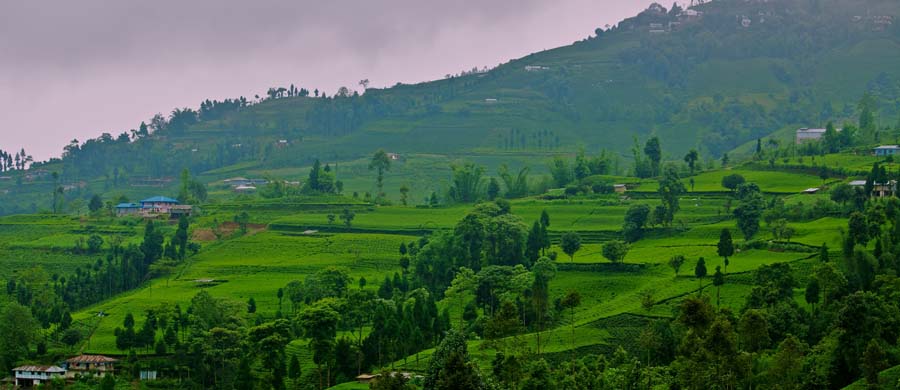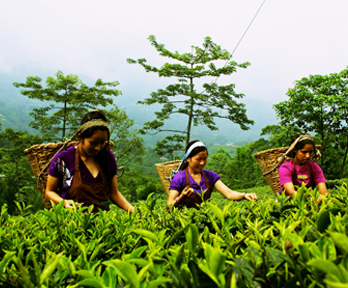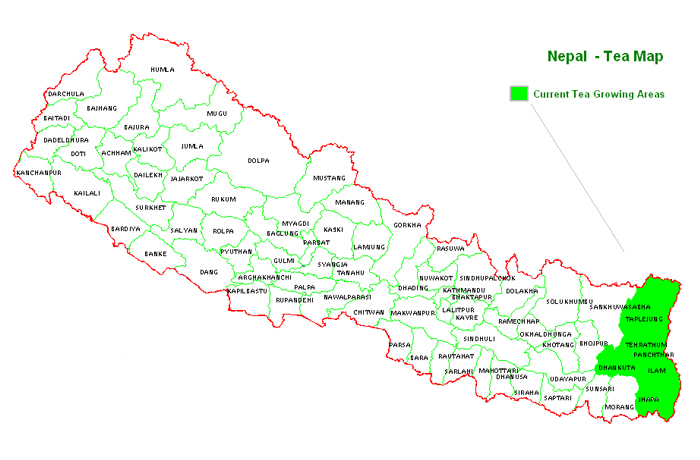Tea in Nepal

 Nestled in the lap of the wondrous Himalayas, This paradise of a country unites with the sun; the wind and the rain – combining together with the fertile earth and the healthy young tea bushes to bring you the best teas in the world. All this natural magic brings out a unique character in the tea, a brew that produces a bright infusion with a relaxing aroma and an exquisite flavor – a satisfaction that tea aficionadas around the world swear by!
Nestled in the lap of the wondrous Himalayas, This paradise of a country unites with the sun; the wind and the rain – combining together with the fertile earth and the healthy young tea bushes to bring you the best teas in the world. All this natural magic brings out a unique character in the tea, a brew that produces a bright infusion with a relaxing aroma and an exquisite flavor – a satisfaction that tea aficionadas around the world swear by!
Although, orthodox black and CTC tea are the majority of teas produced in Nepal, other variation such as green, oolong and white teas are also processed in lesser quantities or as per their demand. Similarly, hand-rolled teas – a traditional variety that is dried naturally and rolled by hand, usually in smaller households in the upper mountainous tea growing regions of Nepal are also made and sold in smaller quantities.
Orthodox teas are usually grown in the mountainous regions of eastern Nepal, across six districts of which Ilam produces the largest quantities, followed by Dhankuta, Panchthar, Terathum, Sindhupalchok and Kaski at an altitude ranging from 3000-7000 feet above sea level. While, CTC tea is mainly grown in the fertile plains of the Jhapa district, at a lower altitude and therefore under a warmer climate.
Orthodox teas in Nepal are usually produced in flushes or tea growing seasons (particular time phases) and are characterized by 4 major flushes:
- First flush: The first flush is usually gathered around the mid of March and continues until the end of April. The young leaves yield a delicate taste with floral aroma in bright yellowish liquor. The first flush teas are usually considered to be more expensive than other flush teas as it is produced in limited quantities and encompass maximum strength in addition to more minerals, due to the almost 4 month rest period for the tea bushes, preceding the flush.
- Second flush: It generally begins during the third week of May and lasts until the first week of July. In the second flush, the teas demonstrate an optimum balance of flavor and aroma in comparison to the first flush teas. The tea leaves have a purplish bloom and a fruity taste in amber liquor. Some experts believe that the best teas are produced during the second flush.
- Monsoon flush: also referred to as “Rain teas” usually starts during the Monsoon season in Nepal from the last week of July and continues until the end of September. The teas produced during this period yield a delicate mellow flavour and a darker infusion.
- Autumn flush: The Autumn flush starts in October and lasts until the end of November. The Autumnal features an extraordinary combination of Musky flavors, rich tangy aroma and amber liquor. It yields another batch of vintage teas to go with the season.
Like orthodox tea, Nepal’s CTC tea is also categorized by four flushes; the First, Second, Monsoon and Autumnal flushes, and like their counterparts, exhibit similar difference throughout the year. Moreover, It should be noted that the time periods are not fixed and are wholly dependent on the weather patterns in the region. Excess rainfall earlier than expected can reduce the timeline of second flush while increasing the rain flush by few weeks and vice versa. The advantage of various flushes is that they bring out different flavours from the tea that is picked from the same plants during different times of the year. Such tastes can satisfy the palates of various tea drinkers effectively.

Nepalese Tea Grades:
The first thing that you need to know about tea grades is that tea comes in many forms and varieties and these depend on the type of tea and the region where it was grown. That said, most of the teas you will come across would be called “Orange Pekoe”. This is not because it has the taste of an orange, it is simply the name given to a Pekoe tea leaf of a certain size and color. It is only this size of tea leaf, which is used in “OP” teas.
There are a number of different grades used to define various black teas, and this list can run on for a long time. Given below is a list of the teas that you can run in to.
Before we begin however, just a few clarifications;
- OP - Orange Pekoe: everything to do with the leaf size and not the flavor of the tea!
- T - Tippy: meaning that the tea contains tips from the tea plant. (The youngest of the leaves)
- G and F - Golden or Flowery: the tea contains buds or tips that have been plucked whilst very young, and have a golden color to them, hence the names Golden and Flowery. (The “F” in this instance is used somewhere in the beginning such as “FBOP – Flowery Broken Orange Pekoe”)
- F - Fannings: are used mainly for tea bags. (This “F” is used at the end of the grade such as “OF – Orange Fannings”)
- B - Broken: the tealeaves are a shade larger than what you would find in fannings.
So, some of the grade definitions you might find on tea are;
- D – Dust
- PD – Pekoe Dust
- PF – Pekoe Fannings
- OP - Orange Pekoe
- BP - Broken Pekoe
- OF - Orange Fannings
- GOF - Golden Orange Fannings
- BOP - Broken Orange Pekoe
- BOPS - Broken Orange Pekoe Small
- FOP - Flowery Orange Pekoe
- FBOP - Flowery Broken Orange Pekoe
- GFOP - Golden Flowery Orange Pekoe
- FBOPF - Flowery Broken Orange Pekoe Fannings
- TGBOP - Tippy Golden Broken Orange Pekoe
- TGFOP - Tippy Golden Flowery Orange Pekoe
- FTGFOP1 - Finest Tippy Golden Flowery Orange Pekoe, Grade 1
- SFTGFOP1 - Super Fine Tippy Golden Flowery Orange Pekoe, Grade 1
The last two grades of tea are some of the finest tea to be found in the world and carry an equally fine price tag! Obviously the higher up the tea ladder you go, the better the quality of tea you will get.

